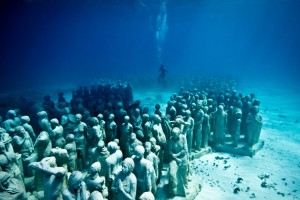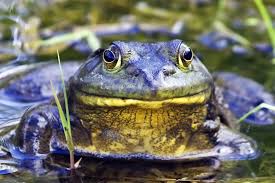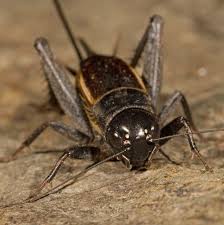In last week’s tutorial, Dr Todd shared with us the impacts of coastal urbanization on biodiversity. More importantly, he made us think about the types of mitigation and rehabilitation strategies we could adopt to enhance biodiversity of sea walls. This is especially relevant to conservation, given that coastal defences are likely to grow in the future, due to increasing urbanization and rising sea-levels. In this post, however, I would like to talk about the importance of scientific communication in aiding conservation efforts.
Over the weekend, I chanced upon a video that reminded me of the class activity I am sure we had all enjoyed (making our own tiles for sea walls!):
Underwater Sculptures Are Helping Rebuild Our Ocean’s Coral ReefsUnderwater artwork is helping rebuild our ocean’s coral reefs.
Posted by The Huffington Post on Wednesday, February 17, 2016
The video showed how a sculptor, Jason deCaires Taylor, made artworks from marine cement with a neutral surface pH and submerged them to form artificial reefs in the ocean. More than being just underwater art installations, these sculptures have allowed the growth of coralline algae on their surface, providing new opportunities and habitats for colonization and regeneration of reef ecosystems. In addition, these breathtaking artificial reefs, located in the off the shores of Mexico and the Caribbean, have diverted attention away from natural reefs that are threatened, allowing them to regenerate.
I thought it was a brilliant example of an innovative human intervention in marine conservation, and its positive impacts on the environment is heartening. Although I am not sure if the level of colonization on these sculptures is comparable to other restoration projects, Taylor’s projects have the potential to allow people to appreciate and connect with nature on a deeper level. Using art as a medium to raise awareness about the plight of the world’s coral reefs makes it more accessible to wider audiences, and highlights the beauty of nature. Such a form of scientific communication, that which frames human interventions as a source of hope, rather than a harbinger of doom, may compel more people to have greater concern for the environment.
Tying it back to what we have learnt in the tutorial, these sculptures have surfaces that are structurally complex, with various nooks and crannies. These surfaces may serve as a good anchor and provide microhabitats for algal and coral growth. In addition, the nature of marine cement allows it to resist currents and the cumulative slowing of currents by these sculptures, which can number up to 400 in a single location, may also contribute to a more stable low energy environment conducive for reef growth. Hence, it is interesting to note how these sculptures, while aesthetically pleasing, also fulfil certain rehabilitative requirements.
Perhaps it is time for us to view conservation in different lenses, expand our horizons, and seek innovative solutions to our environmental problems.
You can find out more about Taylor’s work through his website.
Otters in urban environments
Otters in urban environments
In this week’s class, we have looked at biodiversity in urban environments. Most examples brought up were about birds and bats, with very little mention about larger mammals (except for the coyote and cougar one). Here in Singapore we have few of these mammals that have established in urban environments. They include the common palm civet, long-tailed macaque as well as the smooth-coated otter. I would like to take this platform to write more about the adorable and highly intelligent smooth-coated otters that have been appearing in the news in recent years.
I started working with the smooth-coated otters about 8 months ago when I started my UROPS investigating the home-range and diurnal activity pattern of smooth-coated otters in urban environments. Following this, I did an internship with Beach House Pictures and helped with camera trapping and filming of the smooth-coated otters for Wildcity 3 (2016, Channel News Asia) and Otter City (2016, National Geographic Wild).
A little history about how populations of smooth-coated otters established over the years.
Smooth-coated otters (will be referred to as otters subsequently) used to be around in the 1960s, but disappeared throughout 70s to 80s due to the reclamation of Singapore’s shores (disrupted habitat and water quality) (Sivasothi & Nor, 1994). However, since 1998, the otters were recorded to have established first in Sungei Buloh, followed by Pulau Ubin/Serangoon Reservoir region. Their return to Singapore is due to both the push and pull factor. Pull factor would be that reclamation in Singapore had largely stopped and that the habitat returned and water quality improved. Push factors would be that our neighbour in the north, Johor, had a reclamation project called Project Iskandar and disrupted habitat and water quality over there (Theng et. al., 2012).
Post 2012, saw an increase in sightings of the otters throughout Singapore, particularly in Tanah Merah/East coast region as well as within Marina Resevoir. The otters also established itself within Bishan-Ang Mo Kio Park in early 2015, which is 12km upstream of Marina Reservoir, connected by the Kallang River. Usually when the public encounter otters in highly urbanised environments like Bishan-AMK Park and Marina Reservoir, they often ask: “Where do the otters come from? Is it release from the zoo one arh?” From the timeline of sightings over 2012-2014, it suggests that the otters swam down the east coast and populations established in these unoccupied habitats (Sivasothi, pers comm).
The success of smooth-coated otters in urban environments
In this segment, I will try to answer why smooth-coated otters are successful in occupying urban environments in Singapore. There are 3 main reasons for this:
- Food
- Smooth-coated otters are mainly piscivorous, but are able to accept quite a wide diet as well, and have been recorded in other countries to consume a wide variety of fish, prawns, crabs, amphibians etc. in various studies (Theng & Sivasothi, 2011; Abdul-Patah al., 2014).
- There seems to be sufficient food available in Singapore’s urban waterways (reservoirs, Bishan-AMK Park etc.) to support the current smooth-coated otter population.

Smooth-coated otters feeding on a peacock bass.
Photo credits: Jeffery Teo

Smooth-coated otters in Bishan-AMK Park feeding on a catfish.
Photo credits: Max Khoo
- Urban habitats suitable for day-to-day use by smooth-coated otters
- Smooth-coated otters are semi-aquatic and require access to land to survive as well (Kruuk, 1995). In the day, they use dry areas for grooming (rolling on grass/sand/soil to realign their fur so that it can better trap air when they are underwater) and sprainting (the act of defecation. A gelatinous substance is also released and is used to mark its territory).
- As such, riparian zones are hugely important for otter’s survival. They need to be able to get up to land, and this is only possible if the riparian zones are gentle sloping as opposed to vertical concrete walls of a canal. They were able to adapt to urban environments such as Serangoon Reservoir and Gardens by the Bay because the walls of the reservoirs are sloping. They were able to use Bishan-AMK Park because the river was naturalised and there is gentle sloping riparian vegetation, allowing the otters to traverse between land and water easily.
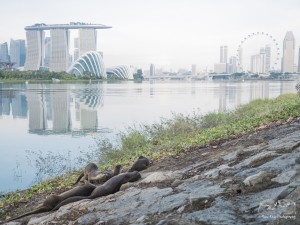
Smooth-coated otters in Marina Reservoir are able to access the adjacent land area by climbing up the sloping seawall. Photo credits: Max Khoo
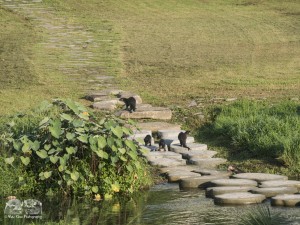
Smooth-coated otters in Bishan-AMK Park are able to access the adjacent land area as the riparian area is gently sloping. Photo credits: Max Khoo
- As such, riparian zones are hugely important for otter’s survival. They need to be able to get up to land, and this is only possible if the riparian zones are gentle sloping as opposed to vertical concrete walls of a canal. They were able to adapt to urban environments such as Serangoon Reservoir and Gardens by the Bay because the walls of the reservoirs are sloping. They were able to use Bishan-AMK Park because the river was naturalised and there is gentle sloping riparian vegetation, allowing the otters to traverse between land and water easily.
- Apart from the 2 above uses, suitable resting/sleeping area is also important for them.
- In the wild, the holt (the term for their resting site) of smooth-coated otters varies. They can dig a hole in a sand bank and use as their holt, create a hole from tall grass e.t.c. Even though the waterways where some of the otters in Singapore are urbanised, there are some areas with natural holts that the otters use that is just beside an urban waterway. For example, the otters are likely resting on Coney Island (natural) and using the urbanised Serangoon Reservoir.
- Some otters are also able to exploit urban sites as holts (Bishan-AMK otters established their holt in a canal), which suggests that they are adaptable to urban environments.
- Smooth-coated otters are semi-aquatic and require access to land to survive as well (Kruuk, 1995). In the day, they use dry areas for grooming (rolling on grass/sand/soil to realign their fur so that it can better trap air when they are underwater) and sprainting (the act of defecation. A gelatinous substance is also released and is used to mark its territory).

A smooth-coated otter seen entering a natural holt in Ulu Pandan. Photo credits: Jeffery Teo

Near Bishan-AMK Park. The smooth-coated otters used to live in this canal. Photo credits: Jeffery Teo
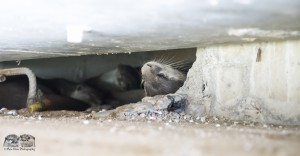
Smooth-coated otters in an urban holt. Photo credits: Max Khoo
- Able to survive
- Little natural predators in Singapore
- Smooth-coated otters have few nautral predators, and hence can survive and establish in Singapore. This is especially so in urban areas, where the only ‘natural’ predator would be stray dogs (they’re not really natural, hence the inverted commas). There have been records of interactions of otters and stray dogs in Marina Reservoir area.
- Humans generally well-behaved
- Fortunately, apart from that 1 fishing-hook incident, Singaporeans generally have not tried to harm the otters. The NParks staff at Bishan-AMK Park and OtterWatch did a wonderful job in their education and outreach campaign and the public is generally well-behaved when they see an otter. Hence, some otters, especially the Bishan-AMK family, is habituated to humans and urban environments.
- Little natural predators in Singapore
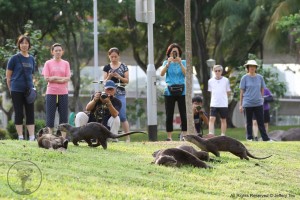
Otters and humans in Bishan-AMK Park. Photo credits: Jeffery Teo
Smooth-coated otters: Urban adapters
So these are the reasons why smooth-coated otters have been successful in Singapore’s urban environments. With these reasons, the smooth-coated otters can be considered as urban adapters. And just last week, 5 more otter pups were born! I am very happy that Singaporeans are able to enjoy wildlife within our city, and do hope that we try to conserve them as long as possible.
Link: https://www.facebook.com/snail.fast/videos/581998451954011/
Other stuff:
For updates on otter stuff in Singapore, do like and follow OtterWatch Facebook page!

Link: https://www.facebook.com/OtterWatch/?fref=ts
Also, do check out www.wildcity.tv to watch Wildcity 1 and 2 if you have not. This 2-part series documentary did a really good job documenting wildlife (both episodes featured otters) in Singapore and Wildcity 2 focuses on urban wildlife!
Lastly, Wildcity 3 will be out pretty soon on Channel News Asia (End March), and will feature more otters along with other awesome animals! Do keep a lookout!
References:
Abdul-Patah, P., N. Nur-Syuhada, S. Md-Nor & H. Sasaki, 2014. Habitat and food resources of otters (Mustelidae) in Peninsular Malaysia. The 2014 UKM FST Postgraduate Colloquium, 1614: 693-699.
Kruuk, H., 1995. Wild otters – predation and population. Oxford University Press, Oxford. 290 pp.
Sivasothi, N. & B. H. M. Nor, 1994. A review of otters (Carnivora: Mustelidae: Lutrinae) in Malaysia and Singapore. Hydrobiologia, 285: 151-170.
Theng, M. & N. Sivasothi, 2011. Status, distribution and diet of the smooth-coated otter Lutrogale perspicillata (Geoffroy, 1826) in Singapore. Unpublished UROPS, National University of Singapore.
Theng, M., N. Sivasothi & H. H. Tan, 2012. Autecology of the Smooth-coated Otter Lutrogale perspicillata (Geoffroy, 1826) alond the Johor Straits, Singapore. Unpublished honours thesis, National University of Singapore.
Book review: some thoughts on “Silent Spring”
I first came to know of this book in Year 1 while taking the module ENV1202 “Communications in Environment”, but never found the time/ motivation to read it. Hearing it being mentioned again during the introductory lecture of this module one month back, I thought it would be a good time to pick this book up. After all, now that I’m a Year 3 environmental studies student, I would probably be better able to appreciate her arguments and writing (as compared to when I was a blur freshie). In this post, I’ll share some personal reflections on Carson’s writing and highlight some points that tie in to what we’ve been learning in Urban Ecology.
In our first lecture, it was mentioned that Rachel Carson’s “Silent Spring” was monumental to the development of the environmental movement. Indeed, Carson’s book (first published in 1962) was arguably the catalyst that helped to put the environmental devastation wrought by man in the forefront of the public’s attention.

There are 2 main reasons why I think her book was so successful in inspiring a change in public mindset:
Firstly, Carson’s background as a scientist and the fact that she was already a best-selling author [1] no doubt helped to establish credibility with her audience. The vocal criticisms by the pesticide industry probably also inadvertently increased publicity for her book and generated public sympathy, resulting in over 2 million copies sold.
Secondly, Carson’s lyrical and simple writing style and choice of examples allowed her engage her audience effectively. For instance, mitochondria are likened to ‘powerhouses’ of energy production (p. 107); acetylcholine is simply explained as a ‘chemical transmitter’ that ‘performs and essential function and then disappears’ (p. 24); highly emotive language such as ‘slaughter’ and ‘massacre’ (p. 52) are used to describe the extent of destruction wrought by overuse of pesticides. Moreover, many examples cited by Carson are not only backed up by statistics, but are also highly relatable to her target audience, showing the direct impact of indiscriminate spraying of insecticides on housewives (pets die), birdwatchers (birds die) and gardeners (plants die) alike.
Overall, I’m reminded of the importance of communicating science to the public in a way that is understandable to the layman, as has been repeatedly emphasized in ENV1202. After all, no matter how amazing or ground-breaking your research finding is, if no one except the scientific community understands its significance, it is unlikely to make any real-world impact.
In the recent lecture on urban vegetation, the Dutch elm disease (DED) was mentioned as an example of the intricate link between urban monocultures and disease prevalence. This example was also brought up in Carson’s book, which highlighted the failure of pesticides in solving the problem, instead compounding it through the bioaccumulation and biomagnification of DDT in the food chain, resulting in near-extermination of migratory robins. Carson thus advocates the use of mechanical (eg. removal of all diseased wood) and genetic controls (eg. producing hybrid elm resistant to DED) over chemical controls.
Beyond this example, Carson’s final chapter argues for the use of biological controls in tackling invasive species by sharing several successful case studies whereby newly introduced species were able to control pest population. However, she fails to mention that using nature to fight nature may backfire too. For instance, the introduction of the Cane toad in 1935 as a biological control against scarab beetles [2] inadvertently resulted in the poisoning of native animals. While we now have better understanding and better technology to mitigate such environmental problems, biological controls should not be seen as a silver bullet as ecosystems are usually more complex and multifaceted than what we imagine.
To conclude, although Silent Spring was published in 1962, it remains as relevant today, given the relentless pace of urbanization and its resultant impact on the environment. Although there has been greater awareness and legislative controls, chemical pollution resulting from pesticide use remains a major issue [3], especially when one considers the potential effects of mixing all these toxic chemicals in the ocean (a thought that frankly scares me).
So read this book, and hopefully when you finish, even though
“Most of us walk unseeing through the world, unaware alike of its beauties, its wonders, and the strange and sometimes terrible intensity of the lives that are being lived about us”
you’ll be able to say “Nope, not me.”
[1] she had won the National Book Award for ‘The Sea Around Us’
[2] These buggers were destroying Australia’s sugar cane crops
[3] See for instance, how the flower you give/ receive on Valentine’s day is not a very loving sentiment from the perspective of the environment
‘Lightening’ up our streets
The lecture on light pollution we had a few weeks ago got me thinking: could some of Singapore’s street lights be removed to lighten the impact of light pollution on our biodiversity?
One way this could be achieved is by closing parks at night, thereby removing the need of lighting at these places. These green spaces tend to house greater biodiversity compared to the more built-up housing estates, and since there is increasing evidence that many animals are affected by lighting at night, it would be a good choice to implement such an initiative.
During my visit to the Shinjuku National Garden in Tokyo last year, I realised that there wasn’t a single street lamp in the entire garden. The gates to the garden would close at 4pm (shortly before sunset in winter) and all visitors had to leave the compounds within the next half hour. Perhaps this system could be adopted in Singapore’s parks, such as in the Botanic gardens and Chinese garden, which are open at night as well. By only allowing visitors in the park during daylight hours, street lights need not be installed, minimizing the impact of artificial lighting on the area’s biodiversity, in addition to reducing our carbon footprint from unnecessary street lights.
However, some might argue that this would deprive citizens of green spaces to unwind in after a long day at school or work – which is essentially what the parks were built for. A way around this issue would be to have fixed opening hours for parks, say from 6am to 12am and switch off the street lights in the park when it is closed. This way, people can continue enjoying these green spaces after their daily activities and the ecological impact of light pollution on biodiversity can be lightened.
What do you think?
The controversies of light and noise pollution on songbirds and their calls
Today in class, we have learnt about urban animal diversity and how the process of urbanisation has threatened or benefited some species, particularly light and noise pollution. The effects of pollution on urban animals are rather well-known from many research works. Even Max and Samantha have written their opinions on living near a loud highway and the effects of anthropogenic noise on acoustic communication in different animals respectively. However, many of these research works only consider the effects of light pollution or noise pollution in isolation. Has anyone ever wondered which form of pollution is more detrimental to wildlife? Sadly, there are very few related research done and hence, there are a lot of controversies.
In this post, I would discuss about the effects of light and noise pollution on songbirds and their calls. This paper by Miller (2006), which was brought up in class today, discussed the effects of light pollution on the singing behaviour of American Robins. As predicted, birds breeding in areas with large amount of artificial light will sing earlier in the day than those in areas with low artificial night. Birds would also sing earlier within a site on brightly lit night. All these results strengthened our understanding on the effects of light pollution on bird calls.
However, there was another paper published that countered the discussion points brought up by Miller. This paper by Fuller et al (2007) argued that daytime noise predicts nocturnal singing in the European Robins and that noise pollution is a stronger factor that affects the time of bird calls. Their results showed that even though nocturnal singing of this diurnal bird did occur primarily in strongly lit areas, it was limited to areas that were also noisy during the day and was absent in most well-lit places that were relatively quiet during the day. This translated that daytime noise in the area had much greater effect on nocturnal singing activity than night-time light levels.
One reason for nocturnal singing is that urban noise frequency coincides with that of the robins, which is approximately 2–9 kHz. This bird may sing at night to reduce the total time spent singing against acoustic competition. Or these intelligent birds take the advantage of quieter conditions during the night to give additional signalling.
However, which form of pollution is more detrimental on bird calls would depend on the species. Noise pollution may be a greater factor than light pollution in explaining the nocturnal singing of European robins as compared to the American robin due to the difference in their size and hence, probably the frequency of their calls. American robins (23 to 28 cm) are generally larger than European robins (12.5–14.0 cm), and so they call at lower frequency by the law of physics. Such differences in the call frequency may be differentially cancelled out by urban noise, hence rendered the ability for calls to reach far. As such, to answer the question of which form of pollution is more impactful to the calls of songbirds would depend mainly on the species that is being investigated.
Reference
Dewey T. & Middleton C. (2002). Turdus migratorius. Animal Diversity Web. University of Michigan Museum of Zoology.
Hume R. (2002). RSPB Birds of Britain and Europe. London: Dorling Kindersley, pp. 263.
Miller W, M. (2006). Apparent Effects of Light Pollution on Singing Behavior of American Robins. The Condor 108, 130 – 139
Richard A, F., Philip H, W., & Kevin J, G. (2007). Daytime noise predicts nocturnal singing in urban robins. The Royal Society, 3(4).
Effects of Anthropogenic Noise on Acoustic Communication in Animals
We’ve covered the issue of noise pollution in class, and Max has even penned his thoughts about living near a (perpetually) loud highway, so I thought it’d be interesting to delve a little deeper into how anthropogenic noise affects animals which rely heavily on acoustic communication.
When we think of acoustic communication, many of us would probably automatically think of birds, with all their lovely (though sometimes raucous) calls (read: Asian koel).
Many species of birds alter their songs by changing the pitch (or for any physicists out there: fundamental frequency) of their songs, or choosing to use more of the high-pitched elements in their existing repertoire. In so doing, they avoid competing against (and losing to) the low-frequency vehicular noises.
Frogs are also known to change their call rates in response to traffic noise. Species with low-frequency calls, such as bullfrogs, call more often in the presence of traffic noise, presumably to increase the chances of females hearing them during a break in the traffic noise.
What about invertebrates? Crickets are a well-known example of insects that rely heavily on acoustic communication. This interesting article describes a recent study conducted on crickets, to determine how traffic noise affects cricket song. The study found that unlike birds, which alter the pitch of their calls, or bullfrogs, which call more often, the crickets actually decreased their call rates in the face of increased traffic noise! This was an unexpected finding, but the authors suggested that it could be a measure adopted to conserve energy (if you can’t beat them… don’t fight them?). It would also be a smart strategy to adopt since traffic noise is not uniform over time, so saving energy during peak hour could mean a higher chance of attracting a mate during the quieter hours.
While I personally marvel at the variety of adaptive strategies adopted by the different species, behavioural changes can have some drawbacks. First off, not every species, or individual in a species, can change the pitch of their calls. This could be due to physiological constraints, or due to the mechanism of call production.
Second, the females of certain species have a preference for mating calls of lower frequencies (as is the case of the bullfrog), often because low-frequency calls are an honest indication of bigger-sized, and thus better quality, males. In such cases, the ability of females to perceive and locate “good quality”, or fitter, males, is diminished.
Third, competing against traffic noise is energetically costly, and could reduce fitness in males.
Taken together, traffic noise does seem to affect animal behaviour quite a bit, in species that rely heavily on acoustic communication. Another thought that occurred to me while browsing these articles was that all these studies examine how animals adapt to their local environments. What about migratory animals that rely heavily on acoustic communication (like birds)? Would they be affected by the differing levels of traffic noise in the different localities they pass along their route? Or will they be able to adapt quickly enough to the changing soundscape?
Of course, this post only touched on how the production and perception of mating calls is affected, but animals also rely on acoustic cues for many other purposes, such as foraging, caring for young, or other forms of social communication (like the alarm calls of squirrels). These are also affected by urban noise in many ways. Feel free to comment with any interesting examples that you know of!
References:
Nemeth, E., & Brumm, H. (2009). Blackbirds sing higher-pitched songs in cities: adaptation to habitat acoustics or side-effect of urbanization? Animal Behaviour, 78(3), 637–641. doi:10.1016/j.anbehav.2009.06.016
Orci, K. M., Petroczki, K., & Barta, Z. (2016). Instantaneous song modification in response to fluctuating traffic noise in the tree cricket Oecanthus pellucens. Animal Behaviour, 112, 187–194. doi:10.1016/j.anbehav.2015.12.008
Potvin, D. A., & Mulder, R. A. (2013). Immediate, independent adjustment of call pitch and amplitude in response to varying background noise by silvereyes (Zosterops lateralis). Behavioral Ecology, 24(6), 1363–1368. doi:10.1093/beheco/art075
Sun, J. W. C., & Narins, P. M. (2005). Anthropogenic sounds differentially affect amphibian call rate. Biological Conservation, 121(3), 419–427. doi:10.1016/j.biocon.2004.05.017
The Hyperloop and Marchetti’s constant
(aka how far can a rollercoaster on steroids get you in 30 minutes)
“An hour wide”
Back in the first lecture, we briefly visited Marchetti’s constant and how this limited travel time limits urban growth.
Marchetti’s constant: the average commute time per person is about approximately 1 hour a day (so about 30 minutes either way if you’re only moving to and from work)
Essentially, this implies that most cities remain an hour wide simply because many people (especially those who live in and around regions named Woodlands and Pasir Ris) instinctively refuse to exceed a daily “travel time budget” (Marchetti, 1994). This, in addition to the factors discussed in the same slide, limits the size a city can grow to.
That being said, it is possible for commute times to stay the same even as a city grows bigger. A possible reason, as proposed by Anas (2014), may be the behavioural switch to modes of public transport which reduces traffic congestion and thereby travel times. If you’re interested, this article gives a good summary of the phenomenon.
Other than behavioural change, another (more obvious) way that commute times can drop is an improvement in the speed and efficiency of available transport modes. But given that our cars, trains, buses and planes probably aren’t going to get much faster than they are right now, surely cities can’t expand that much… can they?
Another mode of transportation?
From the brilliant mind that brought us Paypal, Tesla motors, SpaceX and much more, comes a new concept for a high-speed transportation system.
For those who haven’t already heard or read about it, the Hyperloop is, as Elon Musk puts it, “a cross between a Concorde and a railgun and an air hockey table” (Speed, 2015). Like something out of the popular children’s cartoon “the Jetsons”, the Hyperloop will transport passengers through capsules within a tube system at amazing speeds.
Capable of moving close to the speed of sound (1220 km/h), the Hyperloop will transport passengers between Los Angeles and San Francisco (600 km) in a little over 30 minutes (Musk, 2016). To contrast that to Singapore, it would be the equivalent of moving from the east to west coast (~50 km) in about 3 minutes. (Here’s an idea: toss the Cross-Island Line and build a Hyperloop along the proposed rerouted route. An additional 4 minutes would become… 6 seconds?).

A car ride from Los Angeles to San Francisco would take about 5 hours and 41 minutes, about 11 times slower than the Hyperloop. Source: GoogleMaps
Implications on city limits
As much as I would like to continue writing more about this amazing concept (and its potential issues), perhaps I should go back to how this relates to urban limits.
The Hyperloop, once developed, could be a game-changer in urban development. If 30 minutes in a car at 100 km/h would bring you 50 km from the city centre. Imagine where 30 minutes in the Hyperloop would get you (Answer: very far).
For cities which are mainly limited in size by commute time, the technology could allow for a much greater expansion of their city limits: urbanites can now live much (much) further from the city centre and still reach their work place on time. Might we see urban sprawl happening in these Hyperloop-connected cities? And might this change our ideas of what a “sustainable city” is (especially since the Hyperloop will likely be run on solar power)?
Of course, there are many other factors to consider such as geographical and bioregional constraints when determining a city’s limits. Still though, I believe that the Hyperloop has the potential to significantly change urban transport and development as we know it.
Or maybe all we need is just a new Marchetti’s constant…
References
Anas, A. (2014). Why are urban travel times so stable? Journal of Regional Science, 55(2), 230-261.
Marchetti, C. (1994). Anthropological invariants in travel behavior. Technological Forecasting and Social Change, 47, 75-88.
Musk, E. (August 12, 2013). Hyperloop alpha. SpaceX. Retrieved February 12, 2016, from http://www.spacex.com/sites/spacex/files/hyperloop_alpha.pdf
Speed, B. (January 21, 2015). Elon Musk’s Hyperloop might actually get built. Retrieved February 12, 2016, from http://www.citymetric.com/transport/elon-musks-hyperloop-might-actually-get-built-663
Would you rather live near a stadium that is brightly lit all night or a loud highway?
“Would you rather live near a stadium that is brightly lit all night or a loud highway?”
This was one of the questions that was asked in the discussion section after the urban noise pollution section. We discussed some of the other questions from the discussion last week, but sadly this was not one of them. Hence I thought that I would make use of this blog space to share some of my thoughts and views!
A little context:
My current home is where I’ve been living in all my life. I live on the 17th floor, and this is what the view is like from my balcony:
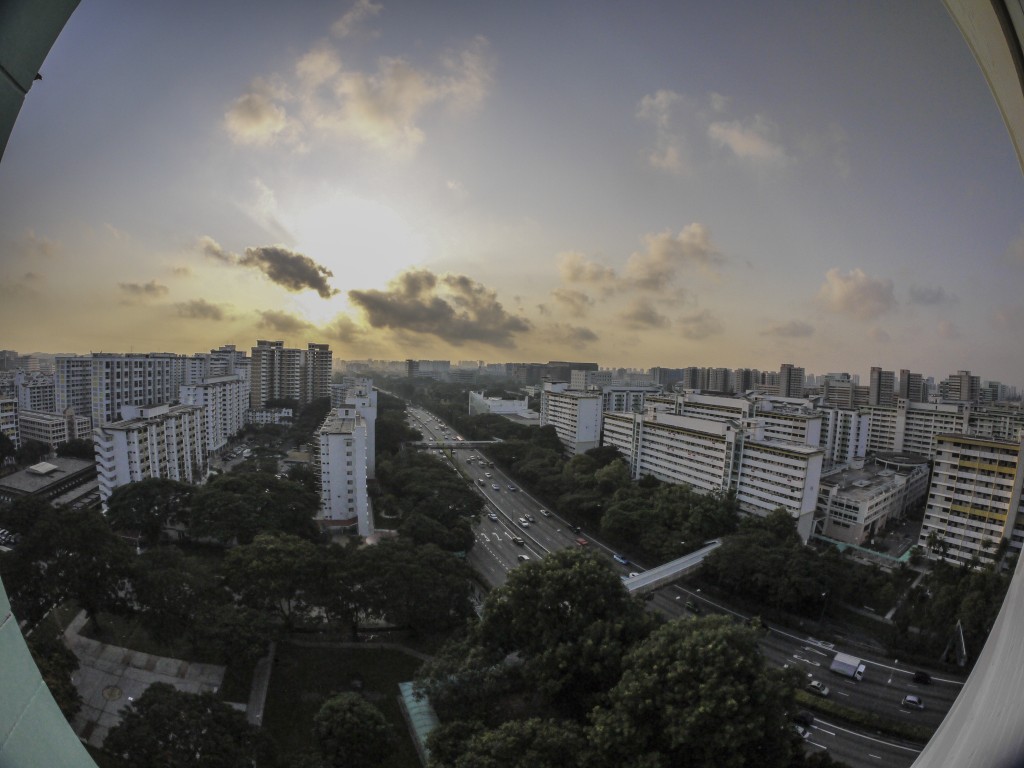
View from my balcony
From the picture it seems pretty obvious that my house overlooks a loud highway. This highway is the Pan-Island Expressway (PIE) that spans from the east all the way to the west of Singapore. In fact, it is also the oldest (built 1966) and longest (42.8km) long.
As I have been living in this home all my life, and sleep with the windows opened (We very rarely use air-conditioning, hence windows are kept open), I have already gotten used to this level of noise pollution. I am able to fall asleep normally as well as concentrate when doing my work with the noise without the help of any sound-cancelling equipment or blasting music.
In fact, I have gotten so used to the noise that I am not able to study in a quiet library because I just cannot concentrate! I also have trouble falling asleep when it is too quiet, like in a hotel room in a foreign country. My parents installed the sound-proof windows about 15 years ago, and when we do close the windows at night with the air-conditioning turned on, I have trouble falling asleep too.
To kind of give you a sense of what it sounds like, I recorded a short 15 second clip:
So here you will hear what it sounds like with my room door closed and soundproof windows closed at first, before I proceed to open the windows. This is 11.22pm at night! As far as I my memories go, there was not once that there wasn’t any cars on the road. It is busy everyday, and even in the late hours there will be cars. It never crossed my mind to ask my parents whether did they consider the noise when they bought this house, but I definitely know that one reason they chose this place is because it is just 5 minutes away from my grandparent’s place!
I was playing with an app, Soundmeter Pro, on my android phone yesterday and decided that I shall do a little test!
I decided to measure the sound from my bedroom with the soundproof windows open and closed.
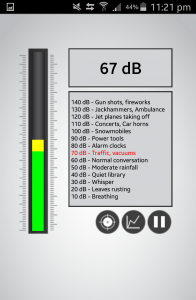
67dB – Sound from my bedroom when windows are opened

49dB – Sound from my bedroom when soundproof windows are closed
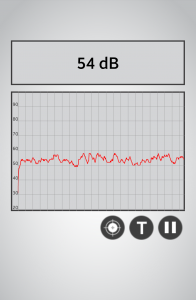
54dB – Sound at more than half empty UHall Spinelli. Today at 3pm. I found out that I can record sound on a chart with time too!
The soundproof windows managed to reduce the sound from 67dB (Normal traffic noise levels) to 49dB (Moderate rainfall noise level) and now I know 67dB is my comfort zone! I wonder if I really have gotten used to it or if my body have been affected/will be affected in other physiological ways that I am not able to tell.
So now back to the question of “Would you rather live near a stadium that is brightly lit all night or a loud highway?”, I think the most practical answer by most people would be the brightly lit stadium because it would be easier and cheaper to get curtains to block the light as opposed to soundproof windows. But as for me, I would choose the loud highway any day (not taking into the considerations of how much dusts as well as air pollutants that I have been breathing in all my life).
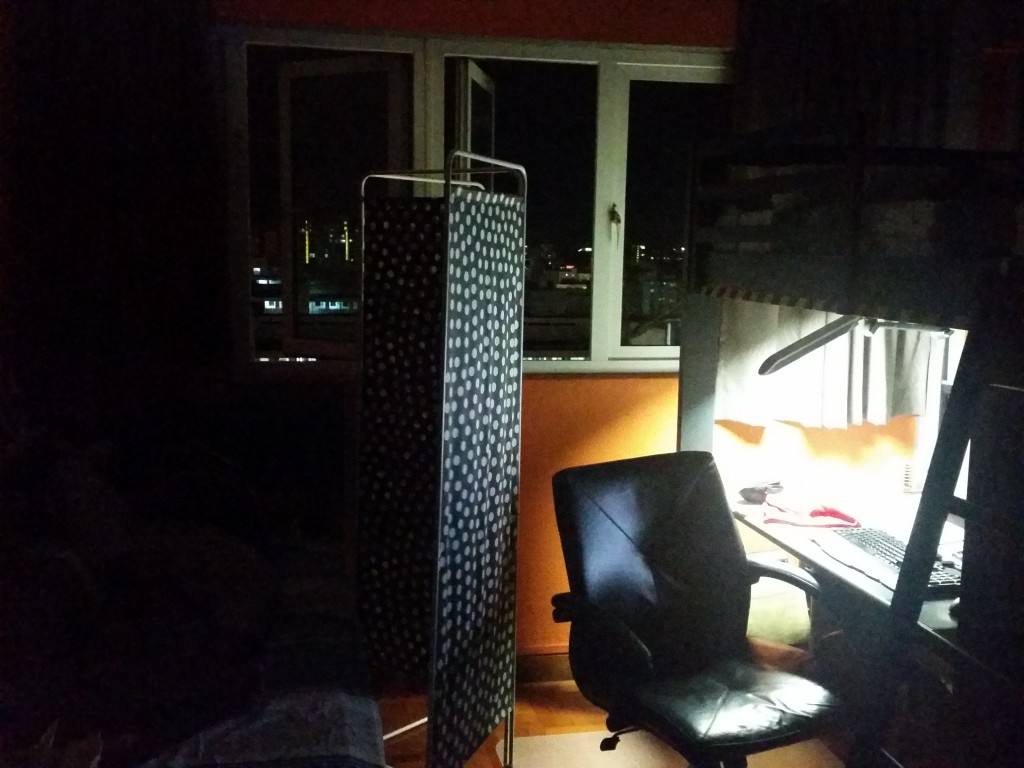
And here is my bedroom that I share with my elder brother. His bed is on the left and is separated from my desk by mobile screen. He has to put up with both the noise and the light when I am using my computer/desk with the lights on to study through the night.
Sources: https://en.wikipedia.org/wiki/Pan_Island_Expressway
Is urbanisation as bad on the environment as it seems to be?
From the past 3 weeks in class, we have been exposed to what is urbanisation and explored the myriad of negative impacts of urbanisation on our environment such as the urban heat island effect, light, water and air pollution and many more. However, after having a thought about what we have covered so far, I started to question:
Is urbanisation as bad on the environment as it seems to be?
I went to look into some literature to find if there are arguments with regards to any positive impacts of urbanisation on our environment. Here are some of my findings:
1) In the book The God Species by Mark Lynas (2011), Lynas put forth that through urbanisation, there can be more sustainable land use when people are living in a denser area. This means that overall, less of natural areas need to be converted into urban areas, thereby protecting the environment. As for the case of rural populations moving into denser cities, it also presents an opportunity to restore these rural landscapes into natural areas (Lynas, 2011).
However, we all have learnt that this is not the case for many cities around the world. The first example of living in denser areas is immediately countered by the example of urban sprawl. Urban areas are growing at a faster rate than population growth rate and more land is being used. In spite of this, I still find that it is invalid to immediately dismiss the benefits of urbanisation in terms of efficient land use and still have to agree with Lynas. I believe that urban sprawl is a problem of poor urban planning and if governments are able to plan effectively, they will be able to restrict the amount of land use. Then, cities will be able to be able to use land more efficiently (although this may be difficult).
2) Living in a denser area also allows some industries to reap economies of scale (Dodman, 2009; Lynas, 2011). One example would be that it is cheaper and use fewer resources when providing electricity and infrastructure in bulk.
3) Dodman (2009) also presented the fact that urbanisation allows for more efficient resource use. For example, the close proximity of homes to workplaces in a city can facilitate the use of greener transport options such as cycling, walking, taking public transport instead of driving to work. However, this is will only work for areas nearer to the core central business district as cycling and walking from further areas may not be feasible, and that public transport system in a city may not expand all the way to the edges of the city where some people are living.
4) Urbanisation creates cities, which are centres for innovation and education because talent pools are concentrated (Grimm et. al., 2008). This provides the potential to find solutions to human’s future problems (and maybe even solutions to environmental problems).
5) Initially, I had the idea that urbanisation is negative because cities have high ecological footprint. However, I realised that urbanisation is just ‘the process by which a rural area becomes an urban one’ (Gaston, 2011). It is not the process of urbanisation that is bad but the result of the unsustainable use of resources by people living within the cities that results in the high carbon footprint of cities.
Overall, we cannot argue that urbanisation does not have any benefits. Although the negative impacts of urbanisation on our environment are currently looking to outweigh the positive ones, I believe that with proper urban planning, it is definitely possible to reduce the impacts of urbanisation on our environment.
References:
Dodman, D. (2009). Blaming cities for climate change? An analysis of urban greenhouse gas emissions inventories. Environment and Urbanization, 21(1), 185-201.
Gaston, K, Ed (2010) Urban Ecology. Cambridge University Press. Cambridge, UK
Grimm, N. B., Faeth, S. H., Golubiewski, N. E., Redman, C. L., Wu, J., Bai, X., & Briggs, J. M. (2008). Global change and the ecology of cities. Science, 319(5864), 756-760.
Lynas, M. (2011) The God Species: How Humans Really Can Save the Planet. London: Fourth Estate. 280p.

